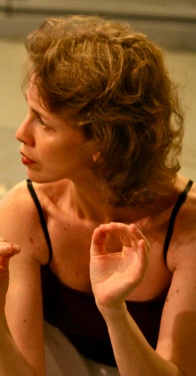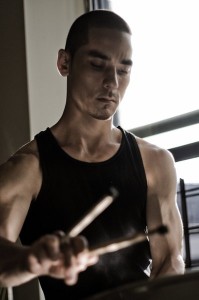Composer/vocalist Sabrina Lastman, whose duo SoCorpo is also a great fixture of the performing arts, is involved in another wonderful project. The Sabrina Lastman Quartet (and they also perform as the Sabrina Lastman Trio sans the drummer) are offering up the tantalizing combination of jazz and world music. Their CD The Candombe Jazz Sessions has been issued this month and was accompanied by a CD release show at Joe’s Pub in NY. They will be also appearing on March 10th at Pregones Theater in the Bronx. Sabrina had a few minutes to spare for a small chat. (more…)
Andy Akiho may have started out as a performer only, but his heart has driven him to become not only a wonderful composer in his own right, but a composer/performer that creates some of the most wonderful and compelling sounding pieces combining steel pans with a variety of instruments from other great new classical musicians. Having studied composition with such greats as Julia Wolfe, David Lang, Ezra Laderman, and Martin Bresnick among others, Akiho had just recently won eighth blackbird’s inaugural Finale National Composition Contest. Andy talked to me about that and some of my favorite works of his. (more…)
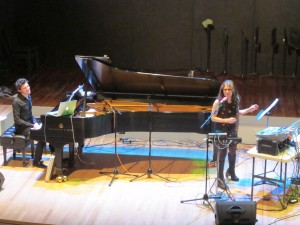 Cory Smythe and Amy X Neuburg; Photos courtesy of Glenn Cornett
Cory Smythe and Amy X Neuburg; Photos courtesy of Glenn Cornett
Amy X Neuburg/Cory Smythe
Roulette
Brooklyn, NY
Dec. 13, 2011
It’s East Meets West…coast, that is.
On the stage of the old-school charming Roulette in Brooklyn was yet another creatively edgy program, put on this time by the pairing of West-coast avant-cabaret artist Amy X Neuburg and New York’s own pianist-composer, ICE’s Cory Smythe. Presented without an intermission, the show was almost entirely electronic or electro-acoustic in nature (with the exception of a refreshing burst of Fats Waller’s “Handful of Keys” from Mr. Smythe), and most of the pieces were composed and/or arranged by both of them. (more…)
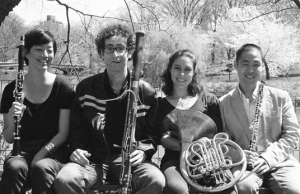
Watching the beginning of a new ensemble is always exciting. But there’s a difference between a group that sets up camp in known territory — say, in the mineral-rich lands of string quartet literature, or in the breadbasket of Pierrot — and a group that strikes out for the wilderness, to make a repertoire where there had been none.
In the last year, I’ve seen the launch of two groups with this mission. The Deviant Septet went to that place Stravinsky discovered in “L’histoire du Soldat” but that was never settled by others — clarinet, trumpet, trombone, bass, bassoon, violin, percussion. They added two new pieces, by Ruben Naeff and Sefan Freund, at their incredibly fun inaugural concert in May. By next May there will 12 more by 12 new composers, all based on Stockhausen’s Tierkreis.
The DZ4 wind quartet (that’s oboe, clarinet, bassoon, horn) has a similar mission, to build a repertoire from scratch through projects that involve many composers tackling similar projects. Their debut concert, “One Hot Minute,” featured 20 one-minute compositions by 20 different composers (I got to be one, and was much rewarded by their terrific musicianship and heartfelt enthusiasm). This Friday they’ll perform their second project, “The Well-Tempered DZ4,” in which 24 composers each take on a different minor or major key.
These groups are doing something that I, especially as a composer, find really inspiring — they’re committing to an unknown music. Composers, go write for them! They’re stellar players, great to work with; check out the concert and say hi.
The Well-Tempered DZ4
Friday October 21st, 2011
10:15pm
Greenwich House
46 Barrow Street, New York
C Major- Jacob Garchik
A Minor- Bradley Detrick
G Major- Karl Kramer
E Minor- Lauren Winterbottom
D Major- Pauline Kim
B Minor- Jonathan Russell
A Major- Evan Premo
F# Minor- Gareth Flowers
E Major- Eric Wubbels
C# Minor- Jane Antonia Cornish
B Major- James Blachly
G# Minor- Ted Hearne
F# Major- Mohammed Fairouz
Eb Minor- Caleb Burhans
Db Major- Mike Block
Bb Minor- David Byrd-Marrow
Ab Major- Charlie Porter
F Minor- Glenn Cornett
Eb Major- Nathan Burke
C Minor- Matt McBane
Bb Major- Ryan Carter
G Minor- Ken Thomson
F Major- Zachary Detrick
D Minor- Ryan Francis
Songs for Persephone: Mimi Goese & Ben Neill

Take a seductive voiced art-pop singer and a post-jazz/alt-classical trumpeter. Add fragments of nineteenth century classical melodies, electronics elicited by a “mutantrumpet” controller. Then add influences ranging from ancient Greek mythology to the Hudson River Valley. What you have are the intricate yet intimate sounds on an evocatively beautiful new CD: Songs for Persephone.
The Persephone legend is one of the oldest in Greek mythology, with many variants that provide twists and turns to the narrative and subtext of the story. In the myth, Persephone, daughter of Zeus and the harvest goddess Demeter, is kidnapped by Hades, god of the underworld. During her absence, vegetation is unable to grow in the world; fields fall fallow and crops cannot be harvested.
To break this horrible time of famine, the gods come to an understanding with Hades. Persephone is eventually freed, but on the condition that, if she has eaten anything while in Hades’ realm, she must return to his kingdom for a certain length of time. Thus, each year she must remain in the underworld one month for each pomegranate seed that she has consumed. This serves to rationalize, in mythic terms, the change of seasons, times of decay and renewal, shifts in light and weather; even the autumn foliage and the falling of the leaves.
Vocalist Mimi Goese and trumpeter Ben Neill have updated the Persephone story, while retaining its iconic essence, on their new recording Songs for Persephone (out now on Ramseur Records). As one can see from the pomegranate on the cover, (a visual designed by Goese), the duo is mindful of the legendary Persephone’s history; but they are not hung up on providing a linear narrative.
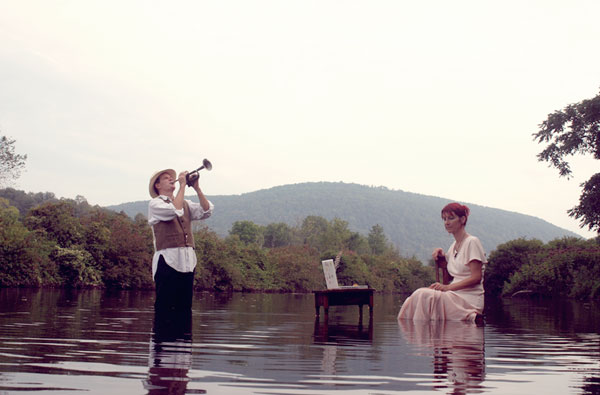
In a recent phone conversation, Goese, who wrote the album’s lyrics, said, “The artwork that I did for the cover, featuring the pomegranate, is one acknowledgement of the myth of Persephone. And there are other images that I found in the lyrics. But we were interested in using what was evocative about Persephone to create our own story. That’s sort of how the myth evolved too – one storyteller picks up the thread from another down through the years.”
They started work on this music some five years ago, but originally presented it as part of a theatrical production by the multimedia company Ridge Theater, starring Julia Stiles. In 2010, it was produced at Brooklyn Academy of Music as part of the Next Wave Festival.
The theatrical presentation and the mythological story behind it are only two strands in a disparate web of influences that resonate with Songs for Persephone. Both Goese and Neill make their home in the Hudson River Valley. Both for its stunning natural surroundings and its history as a home for artists of all sorts, the valley is rich with reference points. Neill feels that these are subtly imparted to the music.
In a recent phone conversation, he said, “I found myself particularly interested in the Hudson River School of painters. These Nineteenth Century artists depicted the local landscape and the changing of season with a dimensionality and symbolism that seemed to have an affinity with what Mimi and I were after in Songs for Persephone.”
For Neill and Goese, these extra-musical influences – artwork, nature, and theater – are an important part of the music’s genesis. But the polystylistic nature of their music making adds still another layer to the proceedings.
Goese says, “I started in dance and theater and later moved to performance art. Singing came along later. But I don’t have the musical background or training that Ben has – I’m self taught.”
[youtube]http://www.youtube.com/watch?v=oG1XgKytxd0[/youtube]
She doth protest too much. Goese’s voice provided the steely, dramatic center to the work of late eighties band Hugo Largo. One part art rock and another dream pop, the group incorporated bold theatricality and ethereal experimentation, releasing two memorable full lengths, Arms Akimbo and Mettle, and the Drums EP, an alt-pop connoisseur’s delight. She’s also collaborated on several occasions with Moby and, under the moniker Mimi (no last name) released Soak, a solo album on David Bryne’s Luaka Bop label.
Goese is a powerful singer, but Songs of Persephone brings out the lyricism her voice also possesses. Cooing high notes and supple overdubbed harmonies are juxtaposed with the more muscular turns of phrase. Experience plays a role in Goese’s tremendous performances on the disc. But she also credits the musical creations of her collaborator Neill with spurring on her inspiration.
“Ben has been a terrific person with whom to work,” Goese says. “He’s inventive and willing to try new things. From the moment we first performed together, at a concert nearly a decade ago, I’ve felt an artistic kinship with him.”
One can readily hear why Neill’s music would be an engaging foil for Goese. His background as a producer, and his years of work designing the mutantrumpet, have encouraged Neill’s ear toward imaginative soundscapes. His 2009 album Night Science (Thirsty Ear) is an example of Neill’s nu-jazz arrangements and soloing at their very best.
On the current CD, Neill’s playing remains impressive; but his arranging and collaborative skills come to the fore. There are intricate textures to found, on which Neill’s trumpet and electronics are abetted by strings, bass, and drums, but it’s the melodies, floating memorably past, one after the other, that are most impressive here. Some of the melodic lines he crafts are imitative of the voice in their own right: it’s no accident that some of the most inspired music-making on Songs for Persephone are when Goese and Neill create duets out of intricately intertwined single lines.
Neill says, “The classical materials that I used as the basis of the compositions on Songs for Persephone were melodies from the Nineteenth century: from opera and symphonic music. Many of them were from relatively the same era in which the Hudson Valley painters worked. I found it fascinating to juxtapose these two genres that were in operation more or less at the same time.”
He continues, “I’d describe the material as fragments of melodies: small excerpts rather than recognizable themes. None of them are treated in such a way that most listeners will be able to say, ‘Hey that’s Berlioz,’ or ‘That sounds like Schumann.’ They were meant to be a starting point from which I would develop the music: it’s not a pastiche.”
At 7:30 PM on September 27th, Goese and Neill will be having an album release party at the Cooper Square Hotel, part of Joe’s Pub’s Summer Salon series. Goese says, “It’s an interesting space – we’ll have glass windows behind us, which is unusual as compared with a more conventional stage. But it’s fun performing in non-standard venues. It allows you to try different things and to bring different elements into the mix in terms of theatricality, lighting, and the way that you play off of each other. I’m excited to see how Persephone changes as we take it into various performing spaces.”
-Composer Christian Carey is Senior Editor at Sequenza 21 and a regular contributor to Signal to Noise and Musical America. He teaches music in the Department of Fine Arts at Rider University (Lawrenceville, New Jersey).
Full disclosure: I co-founded San Diego New Music in 1994, served as its first Executive Director, and have been a board member since 2000. This isn’t a review or a comprehensive report so much as some of my impressions and observations about what’s going on at The Athenaeum in La Jolla, California, this weekend. If you think I overlooked anything, please feel free to contribute more in the comments section below.
After core members of NOISE, the resident ensemble of San Diego New Music, dispersed across the continent (flutist/director Lisa Cella to Baltimore; percussionist Morris Palter to Fairbanks), it became more and more expensive and time-consuming to do an entire season with the ensemble in San Diego. The ingenious solution NOISE came up with was to do an annual festival in June.
This year’s installment is the 5th year of San Diego New Music’s festival, soundON. From the beginning, it’s been impressive for the wide range of musical styles represented on the festival and for the high caliber of their commissions and score submitted through a semi-annual call. Unlike other competitions, there’s no entry fee. The musicians themselves wade through the entries and determine which scores they want to play on the festival.
Last night, the first of the festival, had impressive commissions and nice finds through the calls for scores. Several of the composers in attendance this year have been composers with whom NOISE has developed a relationship over the years: Christopher Adler (who doubles as the Executive Director of San Diego New Music), Stuart Sanders Smith, Matthew Burtner, Madelyn Byrne, and Sidney Marquez Boquiren.
Madelyn Byrne is represented by a video installation by Lily Glass, to which Byrne supplied a soundtrack. I can’t comment on it now, as I spent most of the last night catching up with old friends, but the lovely sounds I did manage to overhear and the colorful still or slow-moving abstractions on the screen invite further exploration tonight and tomorrow. (Update: turns out I heard this two years ago at a new music conference. It’s included on a DVD of works by lesbian composers, Sounding Out. Yes, it is worth experiencing again.).
Time Comes Full Circle, for violin and cello, struck me as completely unique in the output of Stuart Saunders Smith. Framed by an opening and closing spoken dialogue between the instruments the work begins with a mournful modal lament for both instruments, a prismatic minor key duet somewhat reminiscent of Pärt or Schnittke; I’ve never heard anything like this before in Smith’s music. This first section continues exploring this haunting music, only to abandon it for an extensive middle section which is in a vein more typical for Smith: independent, thorny harmonic and rhythmic counterpoint, marked by striking moments where the violin and cello come together in unisons—one, an A 5 spaces above the treble clef. It’s not a perfect unison—at times one instrument drops out and the other takes over, or a heterophonic melody splinters away. The minor-key lament returns in the final section, splintered in new combinations.
Any critic describing Smith’s music is in trouble searching for an easy category in which to pigeonhole him. If he belongs to any school, it’s probably the individualist, intuitive New England branch of experimentalism begun by Ives and Ruggles, later branching off in an intellectually rigorous way by Elliott Carter. Smith’s music, though, strikes me as highly intuitive, seasoned with the acceptance of sounds and free forms of the New York School composers Cage and Brown. Recently, while discussing Smith’s unpredictable style on a podcast focused on experimental art, the host amusingly compared the difficulty of classifying his compositions to ranking sweepstakes casinos — complex and often subjective. Invoking any of these names tells you, only in the vaguest, broadest sense, what his music resembles. He is sui generis. What I can report is that this is an expansive work, a significant contribution to the infrequently explored combination of violin and cello. It was given a wonderful performance by cellist Franklin Cox and violinist Mark Menzies, and Smith seemed genuinely delighted with their interpretation.
A recent solo flute work by Nicolas Tzortzis, Incompatibles III, was dropped from the concert. The program notes are intriguing: “The whole work is based on the idea of ‘going towards something else,’ coming back each time, leaving again, and so on, before reaching the moment of the revelation.” Tzortzis was represented by a frenetic ensemble piece last year which appeared to ring some new changes on the New Complexity style (a distinguishing feature was the amount of repetition and return in the work). I hadn’t encountered his music at all before the Festival last year, and I was looking forward to hearing more. Alas, in its place was Berio’s Sequenza I, given a sharply delineated reading by Lisa Cella. I know it’s a major landmark in flute repertory, and yet taken in the context of all of Berio’s Sequenzas, it is the most dated, the least interesting to 21st century ears. The later Sequenzas developed a modern manner of prolonging dissonant harmonies through a solo instrument; today Sequenza I seems more caught up in the rapid turnover of all 12 tones, as many European composers strove to do in the 1950s.
Christopher Adler is my favorite San Diego composer after Chinary Ung. Aeneas in the Underworld, Act I: The Caves of Cumae suggests a new direction in his music—a music theatre work for reciting guitarist. Chris has two consistent strains in his music, the ethnomusicological (he’s an expert on Thai music) and the mathematical, and Aeneas appears to lean towards the latter. In four “scenes,” guitarist Colin McAllister recites Virgil’s poetry in Latin, while playing a prepared guitar. Like Cage’s prepared piano music, the guitar is more of a percussion instrument here than a melodic/harmonic device, so the focus in the music is on expanding and contracting rhythmic patterns. Over these regimented rhythms, McAllister orates with what I assume is a more natural spoken delivery.
I heard the premiere a month or two back, and was frustrated by the inability to read the text in the dimly lit hall. The music, in general terms, delineates the broad themes of the poetry. Last night’s performance was far more assured, the rhythms crisper, the declamation more confident, and it was greatly helpful to be able to read a translation of Virgil’s text as McAllister recited.
You may have seen this cartoon going around—it’s pretty much an inside joke by Christopher Adler part describing the work to an incredulous guitarist, although in broader terms the interaction between composer and performer is rather true, if cloaked in humorous exaggeration.
A surprise event had been announced for the festival, and after a brief intermission Frank Cox was plunked down in a chair front and center facing the performance area, and serenaded with seven compositions dedicated to him by Claus-Steffen Mahnkopf, Stuart Saunders Smith, Colin Holter, Steven Kazuo Takasugi, Sidney Corbett, John Fonville, and Brian Ferneyhough. The real surprise was Ferneyhough’s piece, titled Paraphrase on Antonin Artaud’s “Les Cenci,” unusual for being the only purely electronic work by Ferneyhough anyone present could recall. It appeared to be constructed entirely from samples, and yet the densities and microtones distinguished it from the average MIDI composition.
SoundON in the past has done “Chill-Out” concerts, which are what you might expect them to be: performances of more meditative, quiet, and/or serene works. Tension Studies I by Samuel Carl Adams, a West Coast composer still in his 20s generating lots of buzz, was scheduled for a Chill-Out performance, yet was withdrawn. In its place was a lovely electroacoustic composition by Matthew Burtner, whose title I do not now recall, composed for Colin McAllister. McAllister is a mountaineer, and recorded sounds of his ascent up the tallest volcano in Mexico; Burtner used these sounds and slowly-changing diatonic harmonies to supply an acoustic foundation over which McAllister played gently oscillating notes, ringing harmonics, and melodies which sounded quasi-improvised. Many folks commented later on how beautiful this work was, and I agree. I had heard it previously, and hearing it for a second time was a pleasant experience.
David Toub will be known to Sequenza21 readers. He submitted a trio for violin, cello, and vibraphone to the call for scores. Christopher Adler, in a preconcert talk, described how Toub’s score—dharmachakramudra—leapt out from all the others, in its being a more austere form of minimalism, a style Adler did not see at all in any of the other 400+ submissions. It is a quiet piece, featuring chords in the violin and cello rocking back and forth with four-note vibraphone chords. If you can imagine Morton Feldman writing a rhythmically regular and shorter piece, or Steve Reich writing a dissonant, slow work, that might give you an idea of the piece.
[youtube]http://www.youtube.com/watch?v=hvVR3t3__2Y&feature=player_embedded[/youtube]
The concert ended with the ocean inside by Frances White, another composer new to San Diegans. Her work was composed for Eighth Blackbird, and incorporated a tape part. It was consonant, lyrical, and a lovely way to end the evening.
And the performances? First class, throughout the night. These performers take their commitment to the music of our time extremely seriously. Doing this festival is a labor of love, and the concern and passion is always evident in everything they play.
Pianist Marilyn Nonken is performing Triadic Memories on June 4 in Philadelphia as part of “American Sublime,” a festival devoted to the works of Morton Feldman. Marilyn was kind enough to tell us a bit about working on Feldman’s music, as well as some of her other upcoming projects.
-What were your early encounters with Feldman’s music like?
I can’t remember my first live Feldman experience as a listener. One of the first works I remember hearing was FOR SAMUEL BECKETT. My first experience playing Feldman was with Ensemble 21, when we performed VIOLIN VIOLA CELLO PIANO, which was just a transformative experience for me, as a chamber player. After that experience, I very much wanted to find a solo work of his to perform and possibly record.
Listening to Feldman is special because there is that great luxury of time. It can take, in Triadic Memories, maybe half an hour or forty-five minutes to get acclimated to the environment of the work, becoming familiar with the subtle details emerging from its unique sonic space. Feldman’s compositions encourage a contemplative mindset, akin to the careful, deliberate engagement one might experience exploring something complex yet intriguing, such as finding the right strategy for the beste online casino Schweiz. In each of his pieces, I think there’s an extended period where the materials introduce themselves, so to speak. It’s not dynamic in the sense of something happening right away, or a conflict being presented, or a big question being asked—and so I feel it’s best to not aggressively try and “figure out” what is happening.
– Which pieces by Feldman have you performed?
VIOLIN VIOLA CELLO PIANO, EXTENSIONS 1, THE VIOLA IN MY LIFE, INTERSECTION 2, PALAIS DE MARI, and TRIADIC MEMORIES —
– What do you think Feldman meant by titling a piece Triadic Memories?
Feldman’s piano music is all about decay, what he would refer to as a kind of receding landscape …. For me, that sense of resonance and the dying of the sound is perhaps the most important part of the piece. His harmonies are gorgeous, very lush and evocative — but as beautiful as they are, more of the piece is spend listening to them fade.
– When did you record Triadic Memories for Mode? Has your performance of the work changed over time?
I believe this is 2004, recorded perhaps summer 2003. I’m sure my performance has changed — although not drastically. In terms of timing and rhythmic precision, I believe it’s very consistent with the recorded version. I’m still convinced by that “magic” (for me) tempo and the specificity of the rhythms, and the way I first conceived of articulating them. But I do feel that I’ve become more sensitive to the harmonic nuances of the work, as I’ve become more familiar with it over the years — the way I voice things, and the way I anticipate the decay, I think, has become more personal.
– While they’re not often showy, Feldman’s pieces make significant demands of their own on performers. Can you tell us a bit about those, and how you prepare to perform Triadic Memories in concert?
I feel these works are very virtuosic, despite the fact that they’re not fast and full of passagework. There’s a moment-to-moment control that Feldman requires, in terms of dynamic and timbre and attack, which requires a tremendous amount of physical and mental preparation. To be that attuned to the smallest nuances, and physically in total control, for such a significant span w/o any real “recess” requires a special kind of concentration. For me, there is no substitute for playing the work — in real time, w/o interruption, — daily for at least a week or two before the concert. There is always detail-work to be done (specificity of rhythms, defining colors, making certain that the surface of the work is somehow “flawless” and w/o rupture — but doing everything sequentially, in tempo, is always a test.
– After Triadic Memories, what are some of your upcoming projects?
I’m very excited to be working again with the fabulous pianist Sarah Rothenberg on a four-hand Kurtag program, combining (as the composer himself has done) Kurtag’s JATEKOK with his Bach transcriptions, presented as a concert program on an upright piano. Sarah and I had a fantastic time working on Messiaen’s VISIONS DE L’AMEN, touring and recording it, and this is a very different and intimate kind of project — I’m also preparing for a recording of American spectralist composer Joshua Fineberg’s complete solo piano music, which will appear on CD with Hugues Dufourt’s recent ERLKONIG — a follow-up to my complete Murail disc. It will feature a new work written for me by Joshua, amd I am very much looking forward to touring with that, as a complete program in itself. And just after this Festival, I’m recording Elizabeth Hoffman’s “organum let open,” a beautiful work she wrote for me last year, based on texts of theatre artist George Hunka. It’s wonderful to be doing such recent music, and inspiring to be working with such talented composers.
[The latest iteration of the always-stellar Other Minds festival is now done and in the books. We asked our equally-stellar Bay Area musician friend Tom Djll if he’d like to cover a bit of it for us, and he happily sent along his impressions of the second and third concert evenings.]
Other Minds 16
Jewish Community Center, San Francisco
Concert Two, Friday, March 4, 2011
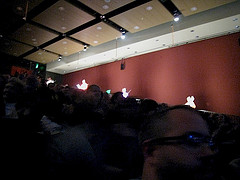 There’s a shard of spotlight on my shoulder. A music stand hovers off the sphere of peripheral vision; under it, the shadow of fingers curl like the violin scroll toward which they crawl, spiderish. The fingers belong to a violinist of the Del Sol String Quartet; on both sides of the audience the quartet and the Left Coast Chamber Ensemble are arrayed up the steps toward the back of the hall. In forward vision is percussionist Andrew Schloss, standing behind a computer and percussion-controller on a table. Over these hover his wired drumsticks, sometimes striking the controller yet often just floating, stirring the atoms above it, sending flocks of musical messages to various slave percussives onstage, offstage, and hung from the ceiling above. The composer is David A. Jaffe, protegé of Henry Brant; the percussion-controller builder, German-born, Seattle-based Trimpin, master of MIDI and commander of solenoid soldiers.
There’s a shard of spotlight on my shoulder. A music stand hovers off the sphere of peripheral vision; under it, the shadow of fingers curl like the violin scroll toward which they crawl, spiderish. The fingers belong to a violinist of the Del Sol String Quartet; on both sides of the audience the quartet and the Left Coast Chamber Ensemble are arrayed up the steps toward the back of the hall. In forward vision is percussionist Andrew Schloss, standing behind a computer and percussion-controller on a table. Over these hover his wired drumsticks, sometimes striking the controller yet often just floating, stirring the atoms above it, sending flocks of musical messages to various slave percussives onstage, offstage, and hung from the ceiling above. The composer is David A. Jaffe, protegé of Henry Brant; the percussion-controller builder, German-born, Seattle-based Trimpin, master of MIDI and commander of solenoid soldiers.
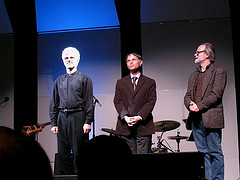 The Space Between Us might be called a “cubistic” composition. The subject is suggested by the title, or “what can be communicated and what remains unsaid,” in the composer’s words, as, with sticks held aloft in a gentle but dramatic gesture, percussionist-conductor Schloss signals yet another beginning, another foray into the problem of separation and identity. Somewhat reminiscent of Ives’ The Unanswered Question, each new attempt answers nothing but only brings more questions to the surface, adding facets to the cubist puzzle in the hearer’s mind. Strings quiver in mournful, canonic dirges in one phase; other times they signal impatience in brusque, un-pretty gestures. Later on, massed plucking is attempted, to better match the percussive chatter. Desperate glissandi from the computer-driven piano onstage are gobbled and hurled back by cello and viola, all to no avail. The space remains and separation seems unbridgeable, yet the sonic discussion has pushed the gloom back for at least a few moments of transcendent, clouds-clearing beauty. The conversation is aptly dedicated to Henry Brant, an Other Minds spiritual father.
The Space Between Us might be called a “cubistic” composition. The subject is suggested by the title, or “what can be communicated and what remains unsaid,” in the composer’s words, as, with sticks held aloft in a gentle but dramatic gesture, percussionist-conductor Schloss signals yet another beginning, another foray into the problem of separation and identity. Somewhat reminiscent of Ives’ The Unanswered Question, each new attempt answers nothing but only brings more questions to the surface, adding facets to the cubist puzzle in the hearer’s mind. Strings quiver in mournful, canonic dirges in one phase; other times they signal impatience in brusque, un-pretty gestures. Later on, massed plucking is attempted, to better match the percussive chatter. Desperate glissandi from the computer-driven piano onstage are gobbled and hurled back by cello and viola, all to no avail. The space remains and separation seems unbridgeable, yet the sonic discussion has pushed the gloom back for at least a few moments of transcendent, clouds-clearing beauty. The conversation is aptly dedicated to Henry Brant, an Other Minds spiritual father.
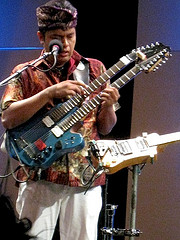 Next up was I Wayan Balawan, guitarist/composer of Bali. OM 16 marked the first appearance in the West of this gifted young man of Olympian technique and globe-trotting musical mind. He also possesses an awareness of stagecraft and audience engagement, reflected not only in his pleasing hybrid music but also humorous asides which broke the performer-audience barrier, and a precise approach to costuming. Onstage with him were, from left, Balinese compatriots I Nyoman Suwida and I Nyman Suarsana on gamelan instruments. They were clothed in traditional Balinese musician dress: Nehru-ish jackets, beaked fezzes, sari-like sashes and bare feet. Balawan himself kept the hat but otherwise he and the added rhythm section (Scott Amendola and Dylan Johnson on drums and bass) decked themselves casually. Sort of a stylistic continuum, with Balawan as the mid-point.
Next up was I Wayan Balawan, guitarist/composer of Bali. OM 16 marked the first appearance in the West of this gifted young man of Olympian technique and globe-trotting musical mind. He also possesses an awareness of stagecraft and audience engagement, reflected not only in his pleasing hybrid music but also humorous asides which broke the performer-audience barrier, and a precise approach to costuming. Onstage with him were, from left, Balinese compatriots I Nyoman Suwida and I Nyman Suarsana on gamelan instruments. They were clothed in traditional Balinese musician dress: Nehru-ish jackets, beaked fezzes, sari-like sashes and bare feet. Balawan himself kept the hat but otherwise he and the added rhythm section (Scott Amendola and Dylan Johnson on drums and bass) decked themselves casually. Sort of a stylistic continuum, with Balawan as the mid-point.
All the brilliance of Balinese music was in evidence as the trio launched into the first of three numbers (Amendola and Johnson laid out at first), with Balawan leading on double-neck electric guitar and voice, and xylophone doubling and drum accompanying. Balawan has all the chops and effects of any guitar god you can name, and his lightning-fast melodies were as often hammered out on the fretboards with one or both hands as they were plucked traditionally. Another electric guitar stood ready on a stand; both instruments were routed through various samplers and synths and footpedals. The tunes shone the happy sunlit sound of dissonance-free scales and world-pop beats. Balawan opened the final number with a demonstration of the hocketing melody as laid out by the Balinese players on each side of a metallophone; part by part, slowly, then briskly together, then doubling with guitar at warp speed in the tune’s performance, and the audience slurped it up like Singapore noodles. This kid is going places.
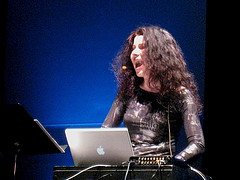 Agata Zubel of Poland opened night two’s second set with Parlando, voice + electronics in a rigorous yet easy-to-digest demonstration of vocal/computer self-accompaniment of the non-looping kind. One might have expected more integration of the hairier side of contemporary vocal extension (Diamanda Galas, Phil Minton, Shelley Hirsch), but Zubel’s range of techniques was focused, precise, and mostly omitted noises in favor of dramatic gestures. The sounds and ambiences immediately brought to mind Cathy Berberian (more on her, later), but then an outbreak of avant-beatboxing shocked one back to this century. Then, after just eight minutes, it was over. (Zubel was given more of a presence on Thursday night.)
Agata Zubel of Poland opened night two’s second set with Parlando, voice + electronics in a rigorous yet easy-to-digest demonstration of vocal/computer self-accompaniment of the non-looping kind. One might have expected more integration of the hairier side of contemporary vocal extension (Diamanda Galas, Phil Minton, Shelley Hirsch), but Zubel’s range of techniques was focused, precise, and mostly omitted noises in favor of dramatic gestures. The sounds and ambiences immediately brought to mind Cathy Berberian (more on her, later), but then an outbreak of avant-beatboxing shocked one back to this century. Then, after just eight minutes, it was over. (Zubel was given more of a presence on Thursday night.)
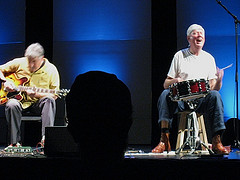 Friday night’s ultimate act was the duo of Han Bennink (drums, Holland) and Fred Frith (guitar, devices, Oakland, by way of England). About esteemed Dutch drummer, improviser, and provocateur Han Bennink’s stage presence, one’s first impression is of a pair of malformed albino salami – wait, those are his legs? – revealed via Bennink’s now-patented stage getup of beachcomber’s shorts, teeshirt and headband. All that was missing was the metal detector, although had there been one available there’s no doubt Bennink would have beat some music out of it. As it was, everything within the man-child’s reach was fair game. That reach extended beyond the stage at times – backstage, an unguarded piano was hijacked for a short joyride; then he turned his back to us and set his bum on the drum and wailed away on the wooden stool; later, Bennink took to rattling his sticks on the railings flanking the audience, giving a fair approximation of gamelan, no doubt an intentional nod to the Balinese set that came before. And for a long while, Bennink simply sat spread-legged on the floor and ecstatically pounded it with his palms, generating an insistent beat in nearly every performing permutation. He also had a snare drum onstage for a few demonstrations of his peerless brush technique.
Friday night’s ultimate act was the duo of Han Bennink (drums, Holland) and Fred Frith (guitar, devices, Oakland, by way of England). About esteemed Dutch drummer, improviser, and provocateur Han Bennink’s stage presence, one’s first impression is of a pair of malformed albino salami – wait, those are his legs? – revealed via Bennink’s now-patented stage getup of beachcomber’s shorts, teeshirt and headband. All that was missing was the metal detector, although had there been one available there’s no doubt Bennink would have beat some music out of it. As it was, everything within the man-child’s reach was fair game. That reach extended beyond the stage at times – backstage, an unguarded piano was hijacked for a short joyride; then he turned his back to us and set his bum on the drum and wailed away on the wooden stool; later, Bennink took to rattling his sticks on the railings flanking the audience, giving a fair approximation of gamelan, no doubt an intentional nod to the Balinese set that came before. And for a long while, Bennink simply sat spread-legged on the floor and ecstatically pounded it with his palms, generating an insistent beat in nearly every performing permutation. He also had a snare drum onstage for a few demonstrations of his peerless brush technique.
Bennink is one of the few improvisers around who can make Fred Frith look like the conservative guy onstage. Frith surely knew what he was in for, and kept his part well under control and always gorgeously musical. He even drew some laughs of his own, strumming the strings of his lap-held guitar with paint brushes. I’ve seen him drop rice grains on his strings a few times before, and this time the stunt made its beautiful, random plinks fit Bennink’s manic-percussive thrash just right, somehow. These two together, who can turn practically any liminal sound-construction into compelling music without ever suggesting a tune or idiom, could lay claim to being the world’s greatest bad buskers.
We’re saddened to learn of James Levine’s cancellation of the rest of his appearances this season at the Boston Symphony Orchestra and his resignation from the post of BSO Music Director. Levine has been in that position since 2004, but has had to cancel a number of appearances during his tenure due to a variety of health problems. In an interview published today in the New York Times, Levine indicated that he will retain his position as Music Director at the Metropolitan Opera. Apparently, conversations between Levine and the BSO about a possible future role with the orchestra are ongoing.
 The BSO plans to keep its season underway with minimal changes apart from substitute conductors. They’re even going to premiere a new work this week under the baton of Assistant Conductor Marcelo Lehninger. In Boston’s Symphony Hall on March 3,4,5, and 8, and at Carnegie Hall in New York on March 15, the orchestra and soloist Christian Tetzlaff will be giving the world premiere of Harrison Birtwistle’s Violin Concerto.
The BSO plans to keep its season underway with minimal changes apart from substitute conductors. They’re even going to premiere a new work this week under the baton of Assistant Conductor Marcelo Lehninger. In Boston’s Symphony Hall on March 3,4,5, and 8, and at Carnegie Hall in New York on March 15, the orchestra and soloist Christian Tetzlaff will be giving the world premiere of Harrison Birtwistle’s Violin Concerto.
It’s bittersweet that Levine is stepping down during a week when an important commission, one of several during his tenure, is seeing its premiere. I made a number of pilgrimages from New York to Boston (thank goodness for Bolt Bus!) to hear him conduct contemporary music with the BSO, including pieces by Harbison, Wuorinen, Babbitt, and Carter. He helped a great American orchestra (with a somewhat conservative curatorial direction) to make the leap into 21st century repertoire and was a terrific advocate for living composers.
Many in Boston and elsewhere have complained that by taking on the BSO, while still keeping his job at the Met, Levine overreached and overcommitted himself. Further, when his health deteriorated, some suggest that he should have stepped aside sooner.
I’ll not argue those points. But I will add that, when he was well, Levine helped to create some glorious nights of music-making in Boston that I’ll never forget. And for that, I’m extraordinarily grateful.
***
I’ll admit that I was a bit surprised to hear that Birtwistle was composing a violin concerto, as it seemed to me an uncharacteristic choice of solo instrument for him. After all, the composer of Panic and Cry of Anubis isn’t a likely candidate for the genre that’s brought us concerti by Brahms and Sibelius (and even Bartok and Schoenberg!).
But then I thought again. Having heard his Pulse Shadows and the recent Tree of Strings for quartet, both extraordinary pieces, I can see why he might want to explore another work that spotlights strings. Perhaps his approach to the violin concerto will bring the sense of theatricality, innovative scoring, and imaginative approach to form that he’s offered in so many other pieces.
I’m hoping to get a chance to hear it when it the orchestra comes to New York. No pilgrimage this time. My next Bolt Bus trip to Boston will likely have to wait ’til next season to hear the BSO in its post-Levine incarnation.
(Houston, TX) On February 25th and 26th at 8pm and February 27th at 2:30 pm (the third date added due to popular demand), the Houston Chamber Choir and Da Camera present Music for Rothko, a concert program of contemporary music in one of Houston’s most unique performance spaces. All three performances are sold out.
Presented in the interior of Rothko Chapel, the Music for Rothko program includes piano works by John Cage and Erik Satie, Tagh for the Funeral of the Lord for viola and percussion by Tigran Mansurian, and choral compositions by John Cage including Four. Feldman’s Rothko Chapel for soprano, alto, choir, celesta, and percussion, is the centerpiece of the program. The performers include the Houston Chamber Choir conducted by Robert Simpson, pianist Sarah Rothenberg, percussionist Brian Del Signore, and violist Kim Kashkashian in her first Houston appearance in more than 20 years.
New Yorker Magazine music critic Alex Ross recently tweeted: “It’s Rothko Chapel week” in reference to several performances taking place this week across the country of Feldman’s elegy for his friend painter Mark Rothko. It is exciting to find out via Twitter that this piece is receiving so much well deserved attention. Last Fall on Sequenza 21, I wrote about the Houston Chamber Choir and this upcoming concert. But I didn’t know at the time that several other performances of the piece would take place within a short span of time. And now I’m interested in contemplating what will set the Houston performance of Rothko Chapel apart from those taking place in other cities?
In his wonderful collection of writings Give My Regards to Eighth Street, Feldman describes Rothko’s paintings as “…an experience in depth…not a surface to be seen on a wall.” Music for Rothko will be complimented by the fourteen paintings Rothko painted for Rothko Chapel; and this setting is one that venues in other cities will not be able to approximate. Rothko’s paintings seem to move beyond the edges of the canvases, their surface appearances changing constantly thanks to the light coming through the chapel’s skylight and Houston’s unpredictable weather patterns. A fusion between the paintings, the architecture of the octagonal room, AND the live music is in store for the chapel’s capacity audiences.
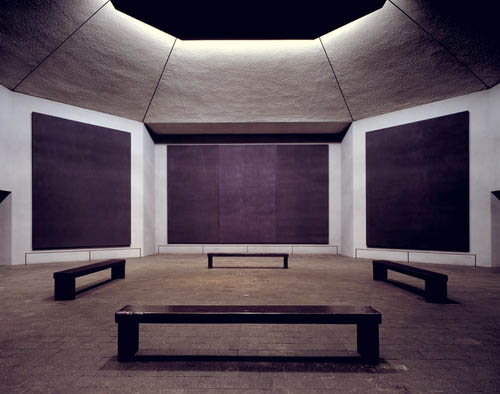
Music for Rothko takes place February 25th and 26th at 8pm and February 27th at 2:30pm at Rothko Chapel. All three Music for Rothko concerts are sold out.
A standby list will be created beginning one hour before the performances, and if there are unoccupied seats, ticket will be sold for $35 at the door beginning about 10 minutes before the concert begins.
